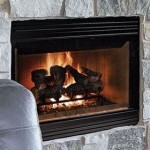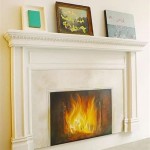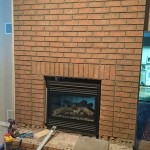The Enduring Appeal of a Custom Stone Fireplace
A fireplace has long been considered the heart of the home, a focal point around which families gather and memories are made. While modern heating systems have become increasingly efficient, the primal allure of a crackling fire remains. The addition of custom stonework elevates this experience, transforming a functional element into a breathtaking architectural statement. Custom stone fireplaces offer a unique blend of natural beauty, enduring durability, and personalized design, making them a sought-after feature in both contemporary and traditional homes.
The decision to incorporate a custom stone fireplace into a home is a significant investment, requiring careful consideration of various factors, including stone selection, design aesthetics, structural requirements, and installation expertise. Understanding these aspects is crucial for achieving a fireplace that not only enhances the visual appeal of the space but also provides long-lasting functionality and safety.
The term "custom" implies a departure from standardized prefabricated options. A custom stone fireplace is designed and built to the homeowner's specific vision, taking into account the unique dimensions of the space, the desired style, and the overall architectural context of the home. This bespoke approach allows for unparalleled personalization and ensures that the fireplace seamlessly integrates with the existing interior design.
Choosing the Right Stone
The selection of the stone is arguably the most critical element in the creation of a custom stone fireplace. The type of stone significantly impacts the fireplace's aesthetic appeal, durability, and overall cost. There is a wide array of stone options available, each with its own distinct characteristics and suitability for different applications. Some of the most popular choices include:
Fieldstone: Characterized by its natural, irregular shapes and earthy tones, fieldstone evokes a rustic and timeless aesthetic. It is typically sourced locally, making it a sustainable and cost-effective option. Fieldstone fireplaces often feature a rugged, textured surface that adds depth and visual interest to the room.
Limestone: A sedimentary rock known for its smooth texture and neutral color palette, limestone offers a more refined and elegant look. It is relatively easy to work with, allowing for intricate carvings and detailing. Limestone is a popular choice for both contemporary and traditional fireplace designs.
Slate: With its distinctive layered appearance and dark, dramatic hues, slate provides a sophisticated and modern touch. It is highly durable and resistant to heat, making it an excellent choice for fireplaces. Slate can be used in its natural state or honed and polished for a smoother, more refined finish.
Granite: Renowned for its exceptional strength and durability, granite is an igneous rock that comes in a wide range of colors and patterns. It is highly resistant to heat, scratches, and stains, making it an ideal choice for high-traffic areas. Granite fireplaces often feature a polished surface that accentuates the stone's natural beauty.
River Rock: Smooth, rounded stones gathered from riverbeds create a unique and organic look. River rock fireplaces often feature a mosaic-like design, adding texture and visual interest to the room. This type of stone is particularly well-suited for creating a natural and calming ambiance.
Beyond the type of stone, factors such as color, texture, size, and shape should also be carefully considered. The choice of stone should complement the overall design scheme of the room and reflect the homeowner's personal aesthetic preferences. It is recommended to consult with a stone supplier or a fireplace designer to explore the available options and determine the best stone for the specific project.
Designing for Aesthetics and Functionality
The design of a custom stone fireplace involves a delicate balance between aesthetics and functionality. While the visual appeal of the fireplace is paramount, it is equally important to ensure that it functions efficiently and safely. The design process should take into account the following considerations:
Size and Proportion: The size of the fireplace should be proportionate to the size of the room. A fireplace that is too large can overwhelm the space, while one that is too small may not make a significant impact. The dimensions of the firebox should also be carefully considered to ensure optimal heat output and efficient combustion.
Style and Detailing: The style of the fireplace should complement the overall architectural style of the home. Traditional homes may benefit from a more ornate and detailed design, while contemporary homes may call for a simpler and more minimalist approach. The detailing of the stonework, such as the type of mortar joint and the texture of the stone, can significantly impact the overall look and feel of the fireplace.
Hearth Design: The hearth is the non-combustible area in front of the fireplace opening. It serves as a safety barrier, protecting the surrounding floor from sparks and embers. The hearth can be made from the same stone as the fireplace surround or from a different material, such as tile or brick. The size and shape of the hearth should be carefully considered to ensure both functionality and visual appeal.
Mantel Design: The mantel is a decorative shelf above the fireplace opening. It provides a focal point for displaying artwork, photographs, and other decorative items. The mantel can be made from a variety of materials, including wood, stone, and metal. The style and size of the mantel should complement the overall design of the fireplace.
Firebox Design: The firebox is the enclosed area where the fire burns. It should be constructed of heat-resistant materials, such as firebrick or cast iron. The design of the firebox should ensure proper airflow and efficient combustion. It is important to comply with local building codes and regulations regarding firebox size and clearances.
Careful planning and attention to detail are essential for creating a custom stone fireplace that is both aesthetically pleasing and functionally sound. Working with a qualified fireplace designer can help to ensure that all aspects of the design are properly considered.
The Importance of Professional Installation
The installation of a custom stone fireplace is a complex process that requires specialized skills and knowledge. Improper installation can lead to safety hazards, performance issues, and costly repairs. It is essential to engage a qualified and experienced professional who is familiar with local building codes and regulations.
The installation process typically involves the following steps:
Structural Assessment: A thorough structural assessment is necessary to ensure that the floor and walls can support the weight of the stone fireplace. If necessary, structural reinforcements may be required.
Framing and Chimney Construction: The fireplace frame provides the structural support for the stonework. The chimney is responsible for venting the smoke and gases from the fire. Both the frame and the chimney must be constructed according to local building codes.
Stone Cutting and Shaping: The stone must be cut and shaped to fit the specific dimensions of the fireplace. This requires specialized tools and expertise in working with stone.
Mortar Application: The mortar is used to bind the stones together. The type of mortar used should be appropriate for the type of stone and the climate conditions. The mortar joints should be properly filled and finished to ensure a watertight seal.
Firebox Installation: The firebox must be properly installed to ensure efficient combustion and safe operation. The firebox should be sealed to prevent smoke from escaping into the room.
Final Finishing and Inspection: After the installation is complete, the fireplace should be thoroughly inspected to ensure that it meets all safety standards and building codes. Any necessary finishing touches, such as cleaning the stonework and applying a sealant, should be completed.
Engaging a professional installer ensures that the custom stone fireplace is installed correctly and safely, providing years of enjoyment and peace of mind. It is important to check the installer's credentials, experience, and insurance coverage before hiring them for the project.
In conclusion, a custom stone fireplace is a significant investment that can enhance the beauty, value, and comfort of a home. By carefully considering the stone selection, design aesthetics, and installation process, homeowners can create a truly unique and enduring focal point that will be enjoyed for generations to come.

Custom Built Fireplace Surround Install A New Mantel Hearth

Stone Fireplace Design Custom Carved Creations

Custom Stone Fireplaces Firepits

Custom Stone Fireplace And Mantel By The Urban Artisan Custommade Com

Manufactured Stone Fireplace Native Custom

Custom Stone Fireplace Modern Living Room Vancouver By Streamline Design Ltd Houzz

Custom Stone Fireplaces

Cost Of Stone Fireplaces Marble Com

Fireplace Stone Veneers Custom Repairs

Custom Stone Fireplaces Rock
Related Posts








